Work From Home Statistics By Productivity of Employees And Market Share
Updated · Nov 27, 2024

Table of Contents
- Introduction
- Editor’s choice
- The Concern of Companies With Hybrid Work
- Trust in Remote Working Productivity of Employees
- Remote Work Satisfaction Among Organizational Leaders
- Advantages of Remote Work
- Company Planning For Permanent Work-From-Home
- Work-Life Balance Among Remote Workers
- Popular Employee Surveillance Companies
- Office Productivity Tools Market Share
- Work From Home Overview
- Conclusion
Introduction
Work From Home Statistics: Remote work refers to the practice of individuals working at home or another space rather than working in a traditional office setup. In current times, work-from-home policies have become deeply integrated into corporate structures worldwide, with companies globally implementing some form of remote work policy.
By learning through Work Home Statistics, we can learn remote work facilities have not only reshaped organizational dynamics but have also led to significant impacts on productivity, cost savings, and employee satisfaction, marking a fundamental change in how we approach work in the modern era.
Editor’s choice
- 71% of companies plan to permanently allow some form of remote work
- Companies save an average of $11,000 per employee annually through remote work arrangements
- 54% of leaders express confidence in remote employee productivity
- 63% of leaders report high satisfaction with one office day per week policy
- 22% of employees value time flexibility as the top remote work benefit
- 40% of respondents describe their work-life boundaries as “very healthy”
- DeskTime leads surveillance tools with a 232% increase in search volume
The Concern of Companies With Hybrid Work
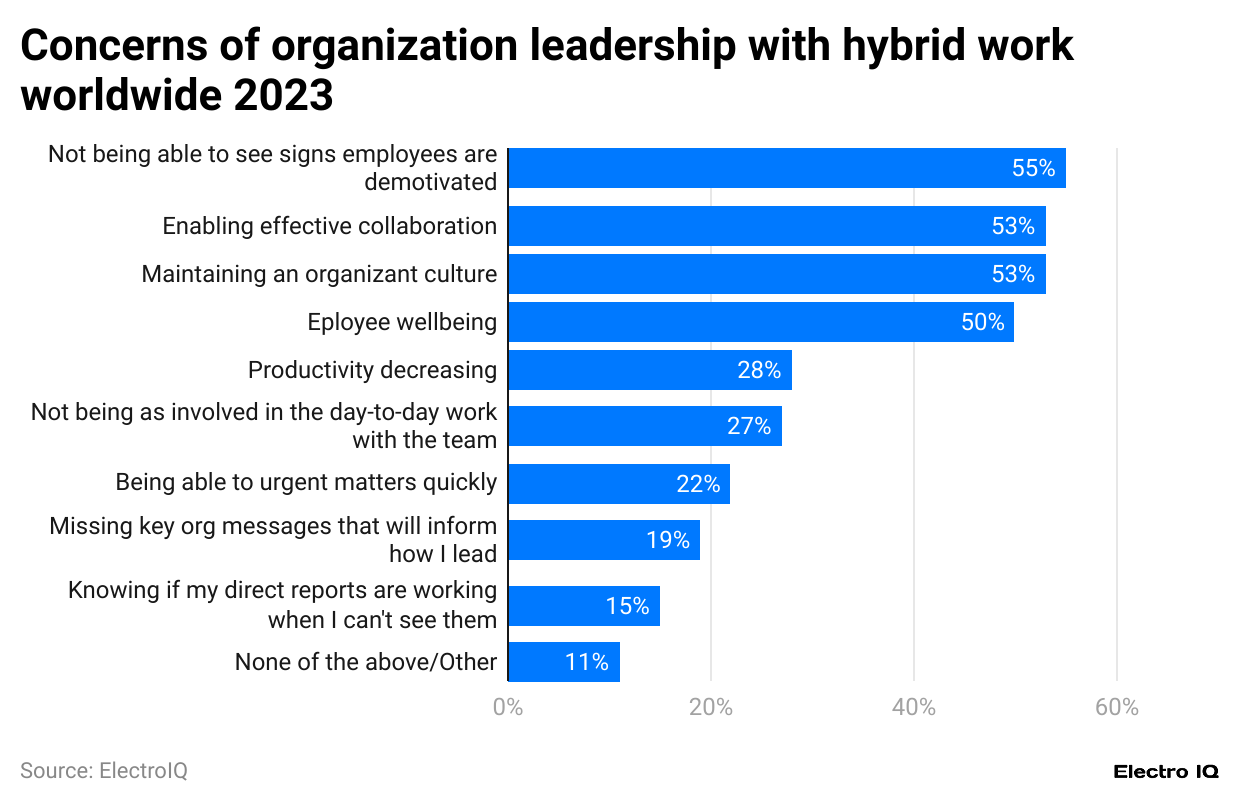
(Reference: statista.com)
- Work Home Statistics show that Organizational leaders are generally concerned about the challenges hybrid work brings to team dynamics, particularly around maintaining motivation, collaboration, and a strong company culture and ensuring employee well-being.
- 55% of leaders believe that not being able to detect early signs of employee demotivation due to limited face-to-face interaction can impact overall team morale and remains a major concern.
- Effective collaboration is seen as challenging by 53% of leaders, as hybrid setups can hinder smooth communication and teamwork compared to traditional office environments.53% worry about maintaining a strong organizational culture, fearing that hybrid work may dilute company values and team cohesion over time.
- 50% are concerned about employee well-being, as remote work may lead to burnout or isolation without the support provided by in-person interactions. 28% of leaders are concerned about potential productivity drops, as hybrid work may make it harder to maintain focus and accountability.
- 27% of leaders, not being directly involved in daily team activities is a significant issue, affecting team guidance and real-time feedback. Meanwhile, 11% of leaders feel uncertain about the productivity of their direct reports when they are not physically visible, leading to concerns over work progress.
Trust in Remote Working Productivity of Employees
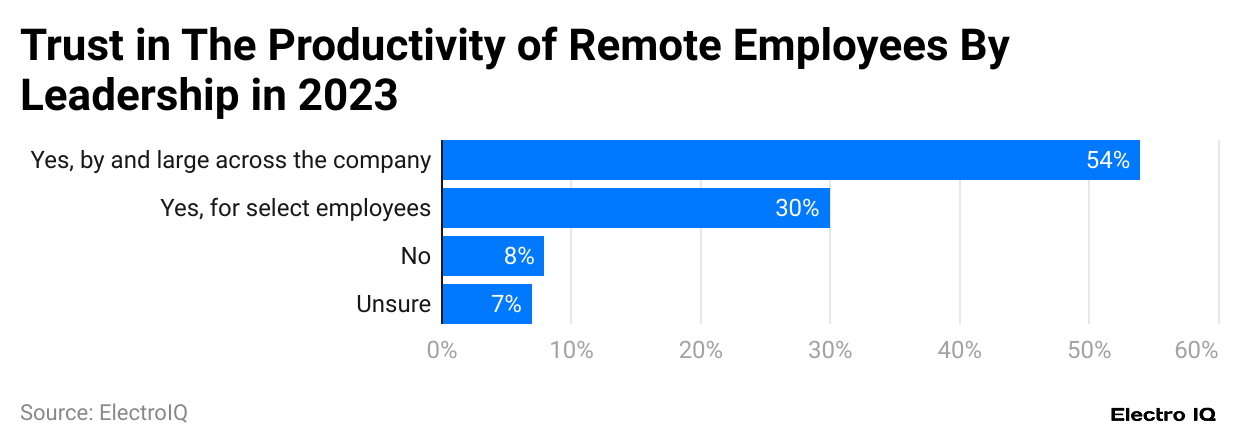
(Reference: statista.com)
- Work From Home Statistics show that most organizational leaders generally trust remote employees’ productivity. However, this trust varies between company-wide confidence and selective employee trust.
- 54% of leaders express confidence in the productivity of remote work across the entire company.30% of leaders trust the productivity of specific remote employees, indicating selective confidence rather than a company-wide approach.
- 8% of leaders do not trust the productivity of remote employees, and 7% of leaders need clarification about the productivity of their remote teams.
Remote Work Satisfaction Among Organizational Leaders
(Reference: statista.com)
- Work From Home Statistics show that technology industry leaders' satisfaction with remote work policies in 2023 varies significantly based on the number of in-office days per week, with higher satisfaction levels associated with fewer office days.
- 63% of leaders report high satisfaction (extremely well) with a policy of one office day per week, decreasing to 45% for five office days. For policies with two and three office days per week, satisfaction is mixed, with "quite well" satisfaction at 28% and 23%, respectively.
- Policies requiring four to five office days per week see a notable increase in dissatisfaction, with 18% reporting "quite poorly" and 7% indicating "extremely poorly" for a four-day requirement.
Advantages of Remote Work
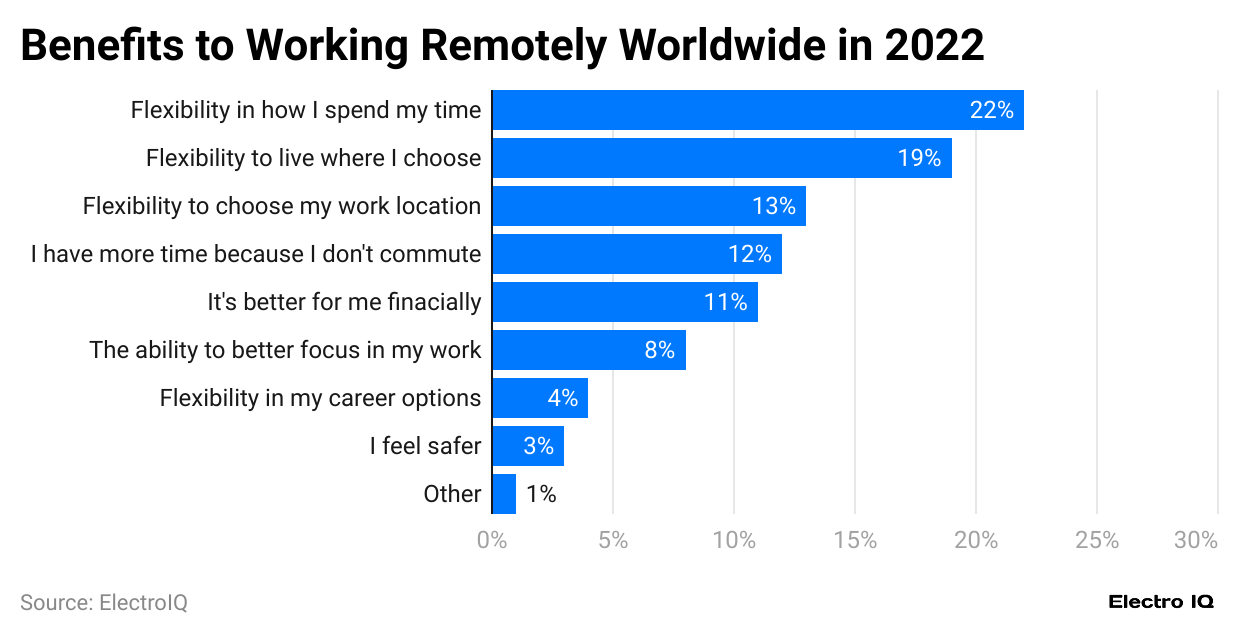
(Reference: statista.com)
- Work Home Statistics show that the main benefits of remote work in 2022, as seen globally, include flexibility in personal scheduling, location choice, and financial advantages, providing employees more control over their work-life balance.
- 22% of respondents appreciate the flexibility in how they spend their time, making it the top benefit.19% value the freedom to live where they choose, offering more location independence.
- 13% enjoy selecting their work environment, tailoring it to personal preferences.12% highlight the benefit of not commuting and gaining more free time.
- 11% find remote work financially advantageous, likely due to reduced commuting and associated costs.8% report better focus, while 4% appreciate remote work's flexibility in career options.
Company Planning For Permanent Work-From-Home
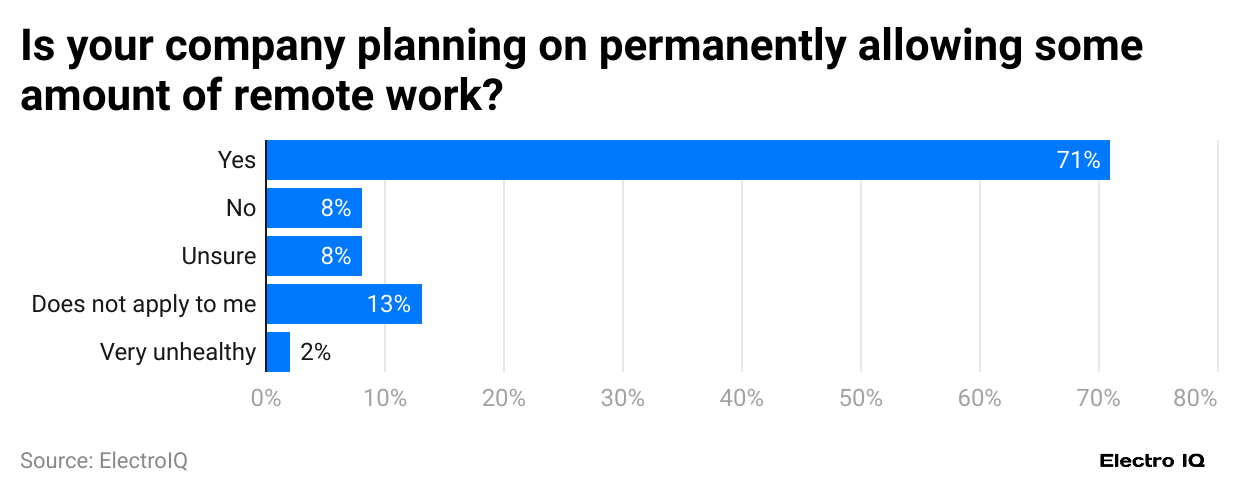
(Reference: statista.com)
- Work From Home Statistics show that most companies globally plan to incorporate some level of remote work permanently, reflecting a shift toward flexible work arrangements.
- 71% of companies plan to permanently allow some remote work, indicating widespread support for hybrid models.8% of companies do not intend to enable remote work, and another 8% still need to decide their future approach.
- 13% of respondents said that remote work policies do not apply to their roles. At the same time, 2% of respondents view remote work as very unhealthy for their organization.
Work-Life Balance Among Remote Workers
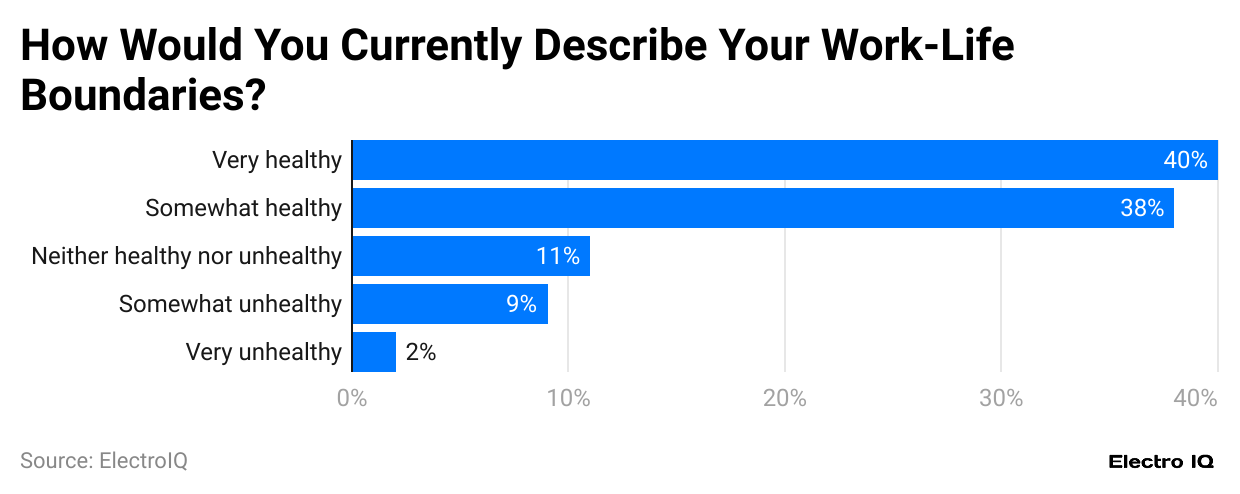
(Reference: statista.com)
- Work From Home Statistics show that employees perceive their work-life boundaries as generally healthy, indicating a positive balance in managing professional and personal responsibilities.
- 40% of respondents describe their work-life boundaries as "very healthy," while 38% consider them "somewhat healthy," showing high satisfaction with work-life balance. 11% view their boundaries as neither healthy nor unhealthy, suggesting a balanced but unremarkable experience.
- 9% feel their boundaries are "somewhat unhealthy, and 2% consider them "very unhealthy," indicating areas for potential improvement in work-life balance.
Popular Employee Surveillance Companies
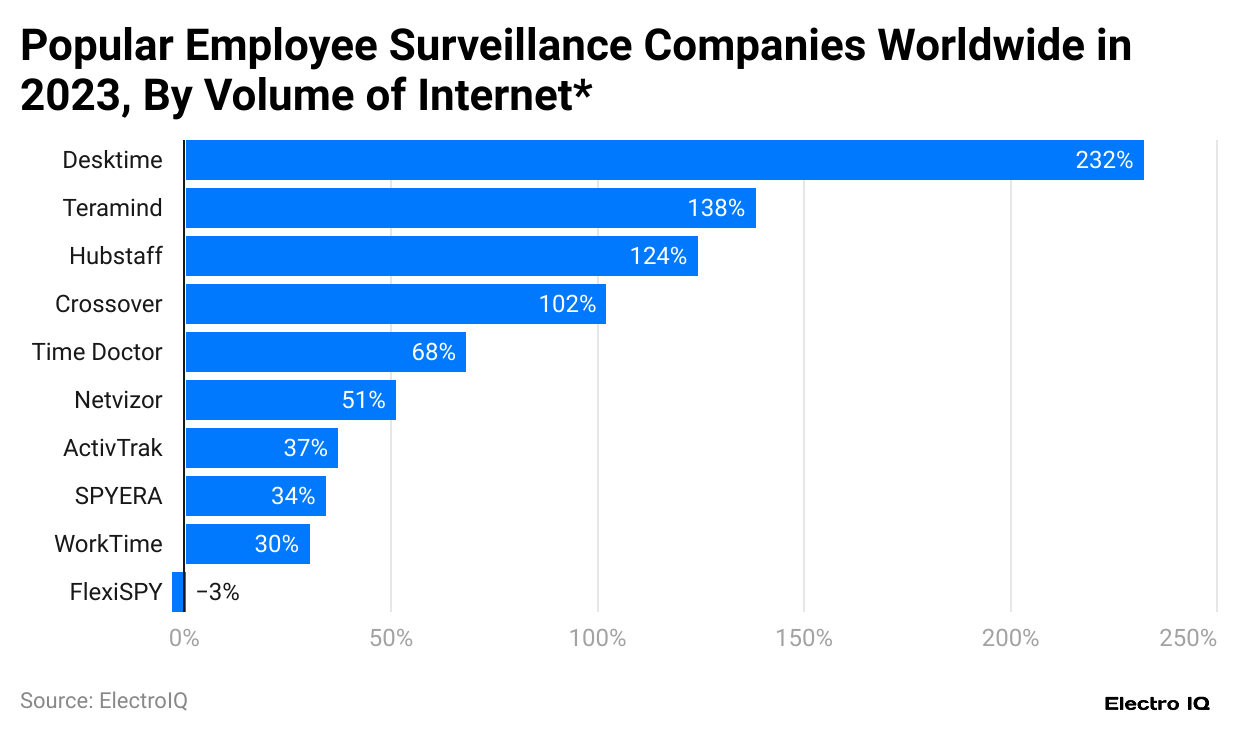
(Reference: statista.com)
- Work From Home Statistics show that the popularity of employee surveillance software has seen a significant increase in search volumes, with certain platforms experiencing substantial growth, indicating a growing interest in employee monitoring solutions.
- DeskTime leads with a 232% increase in search volume, reflecting the highest interest among surveillance tools. Teramind and Hubstaff also saw high growth, with increases of 138% and 124%, respectively, showing strong demand for these tools.
- Crossover and Time Doctor have relatively lower popularity, with 102% and 68% of the internet being used.
- FlexiSPY is the only platform with negative popularity, with - 3% change in internet volume.
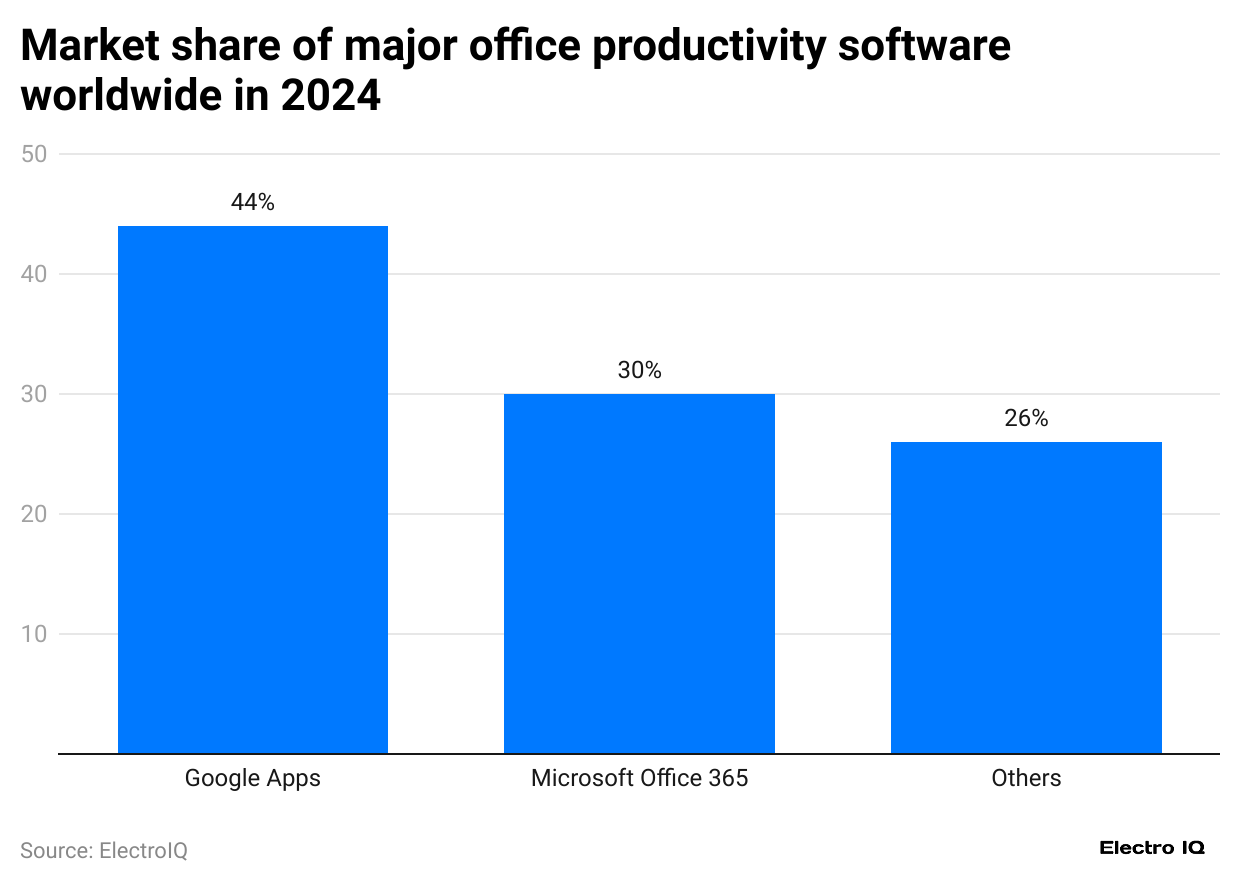
(Reference: statista.com)
- Work From Home Statistics show that Google Apps leads the global market for office productivity software, with Microsoft Office 365 as a close competitor among office tools.
- Google Apps holds the largest market share at 44%, showing its strong global presence in office productivity software. Microsoft Office 365 follows with a 30% share, indicating significant usage but trailing Google Apps.
- The remaining office tools have only a minimum of 26% of the market share.
Work From Home Overview
The global work environment has transformed significantly since the pandemic, making remote work or work-from-home (WFH) setups a prevalent option for employees worldwide. Companies have adapted to this change, seeing benefits and challenges in equal measure. In 2023 and 2024, work-from-home policies have continued to impact the workforce across different industries, with a growing acceptance among companies. This article will provide an in-depth look at Work From Home Statistics, highlighting the trends, financial implications, and the evolving preferences of employers and employees.
#1. Work From Home Adoption Rates
In 2023, approximately 40% of companies globally had some form of work-from-home policy in place. As a result, nearly half of the workforce in developed economies like the United States, the United Kingdom, and parts of Europe experienced remote work benefits. According to recent Work From Home Statistics, the trend is anticipated to grow in 2024, with around 43% of companies planning to maintain hybrid or fully remote work policies. This gradual increase reflects the companies’ focus on flexibility and the need to attract talent by offering remote work options.
#2. Cost Savings for Businesses and Employees
From a financial perspective, both employers and employees have reported cost savings through remote work arrangements. For employers, reduced office space requirements have led to significant savings. On average, businesses save approximately $11,000 per employee per year in the United States by allowing remote work, as fewer resources are spent on maintaining office spaces. By 2024, it is estimated that total cost savings could rise by 5% to $11,550 per employee, reflecting the continued adjustment to remote setups.
Employees have also benefited financially. With fewer commutes, employees in major cities save on fuel and transportation expenses. For instance, in 2023, the average employee in the U.S. saved around $2,500 in commuting costs and work-related expenses. This figure is projected to increase slightly in 2024, with potential savings reaching up to $2,650 per employee. The flexibility to work from home is not just about convenience; it also provides tangible financial benefits in terms of US dollars saved each year.
#3. Impact on Productivity and Efficiency
Productivity is a critical factor for companies considering work-from-home policies. Based on Work From Home Statistics from 2023, around 52% of employers reported either no change or an increase in productivity among their remote employees. Many companies have noted that employees, without the daily commute, could dedicate more time to work. By 2024, studies predict a slight increase in productivity levels, with approximately 55% of companies expecting consistent or improved performance from remote workers. These gains are attributed to a better work-life balance and reduced burnout from commuting stress.
#4. Challenges of Work From Home
Despite the benefits, work-from-home arrangements also pose challenges. In 2023, about 35% of business leaders expressed concerns about maintaining company culture in a remote setting. For many companies, having employees work remotely can lead to feelings of isolation and disconnect, especially if the work-from-home arrangement is full-time. Work Home Statistics indicate that 38% of employees reported feeling less engaged with their team and company in 2023 due to the lack of in-person interactions.
Furthermore, managing productivity remains a concern. In a 2023 survey, 28% of employers voiced issues with monitoring and maintaining productivity levels when employees are not physically present in the office. Companies have adopted software tools to track productivity and time management, which can be effective but sometimes lead to privacy concerns among employees. In 2024, the percentage of businesses using employee monitoring tools is expected to rise to 30% as more employers look to balance productivity and employee autonomy in a remote work environment.
#5. Employee Satisfaction and Work-Life Balance
One of the primary advantages of work-from-home arrangements is the improvement in work-life balance. In 2023, Work From Home Statistics showed that 62% of employees preferred working remotely due to the flexibility it offered. Employees reported having more control over their schedules, with the ability to manage personal and professional responsibilities better. This trend is expected to continue in 2024, with 65% of employees expressing a preference for at least partial remote work.
Work-from-home arrangements are also linked to higher employee satisfaction. In 2023, around 70% of remote workers reported feeling satisfied with their job, compared to 63% of on-site employees. This difference suggests that remote work plays a role in job satisfaction, as employees can structure their workday to suit their personal needs. Companies that promote flexibility are likely to attract and retain talent, making work-from-home policies a valuable asset in recruitment.
#6. Technology and Security
The work-from-home trend has spurred growth in remote work technology, with increased demand for tools like video conferencing, project management, and cloud storage solutions. According to Work From Home Statistics, companies globally spent around $13 billion in US dollars on remote work technology in 2023. This investment is projected to grow by 8% in 2024, reaching approximately $14 billion, as organizations prioritize security and efficiency.
However, the shift to remote work has raised cybersecurity concerns. In 2023, 45% of companies reported a rise in security incidents due to remote work, as employees accessed company networks from various locations. This percentage is expected to increase slightly in 2024, prompting businesses to invest in stronger cybersecurity measures. Companies are focusing on training employees in cybersecurity best practices and implementing multi-factor authentication to reduce potential security risks associated with remote work.
#7. Environmental Impact
One often overlooked benefit of remote work is its positive impact on the environment. In 2023, the reduction in commuting contributed to a decrease in carbon emissions, as fewer cars were on the road. Studies estimate that remote work in the United States alone reduced carbon emissions by 7 million metric tons in 2023. If the work-from-home trend continues to grow, experts predict a further 10% reduction in emissions in 2024, demonstrating how remote work can support environmental goals.
#8. Future Outlook
As we move further into 2024, it is evident that work-from-home arrangements are here to stay. The flexibility offered by remote work appeals to both employees and employers, with financial, productivity, and environmental benefits supporting the trend. Work From Home Statistics indicate that companies worldwide will continue to adapt, finding the right balance between remote and on-site work to meet the needs of their workforce.
However, challenges like maintaining company culture, managing productivity, and addressing security risks will require ongoing attention. Companies that invest in the necessary tools, provide flexibility, and support their employees' needs will likely succeed in retaining talent and optimizing productivity. In the coming years, work-from-home policies may become a standard part of the modern workplace, shaping the future of work and redefining what it means to have a healthy work-life balance.
The continued analysis of Work From Home Statistics will be crucial in understanding the long-term impact of remote work on business operations, employee satisfaction, and environmental sustainability.
Conclusion
The analysis of work-from-home statistics reveals a transformative shift in workplace dynamics that extends beyond temporary adaptation to become a permanent feature of modern business operations. Work From Home Statistics show that it demonstrates substantial benefits in terms of cost savings, with companies saving $11,000 per employee annually and employees saving $2,500 in commuting costs.
While challenges exist in maintaining company culture and ensuring cybersecurity, the overall trend shows positive outcomes in terms of productivity and employee satisfaction. Likewise, remote work models will continue to evolve and shape the future of work, driven by employee preferences.
Sources
FAQ.
71% of companies globally plan to permanently allow some form of remote work
Companies save approximately $11,000 per employee annually through remote work arrangements.
54% of leaders express company-wide confidence in remote worker productivity, while 30% trust specific employees.
22% of employees cite flexibility in how they spend their time as the top benefit.
70% of remote workers report job satisfaction compared to 63% of on-site employees.
Google Apps leads with 44% market share, followed by Microsoft Office 365 at 30%.

Saisuman is a skilled content writer with a passion for mobile technology, law, and science. She creates featured articles for websites and newsletters and conducts thorough research for medical professionals and researchers. Fluent in five languages, Saisuman's love for reading and languages sparked her writing career. She holds a Master's degree in Business Administration with a focus on Human Resources and has experience working in a Human Resources firm. Saisuman has also worked with a French international company. In her spare time, she enjoys traveling and singing classical songs. Now at Smartphone Thoughts, Saisuman specializes in reviewing smartphones and analyzing app statistics, making complex information easy to understand for readers.










